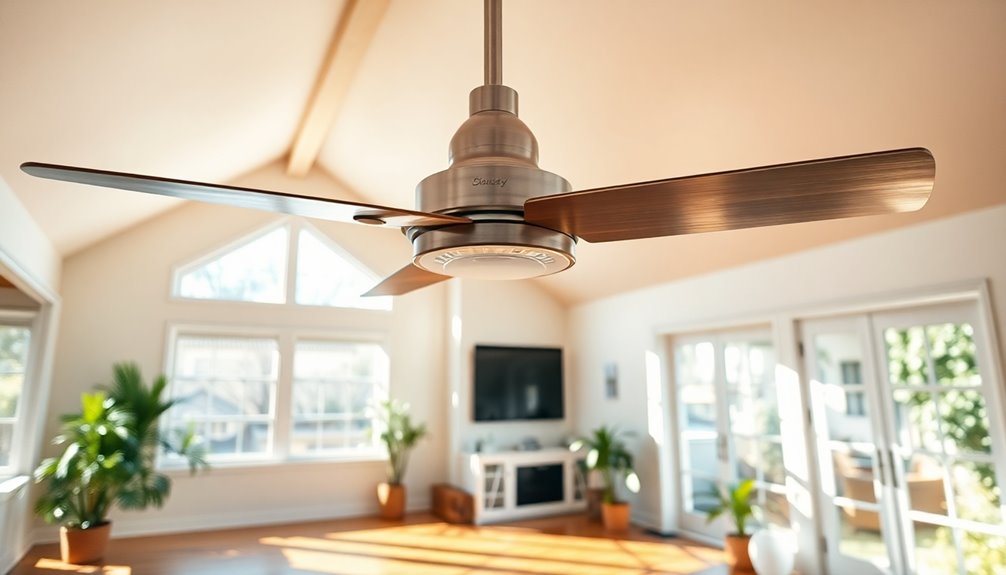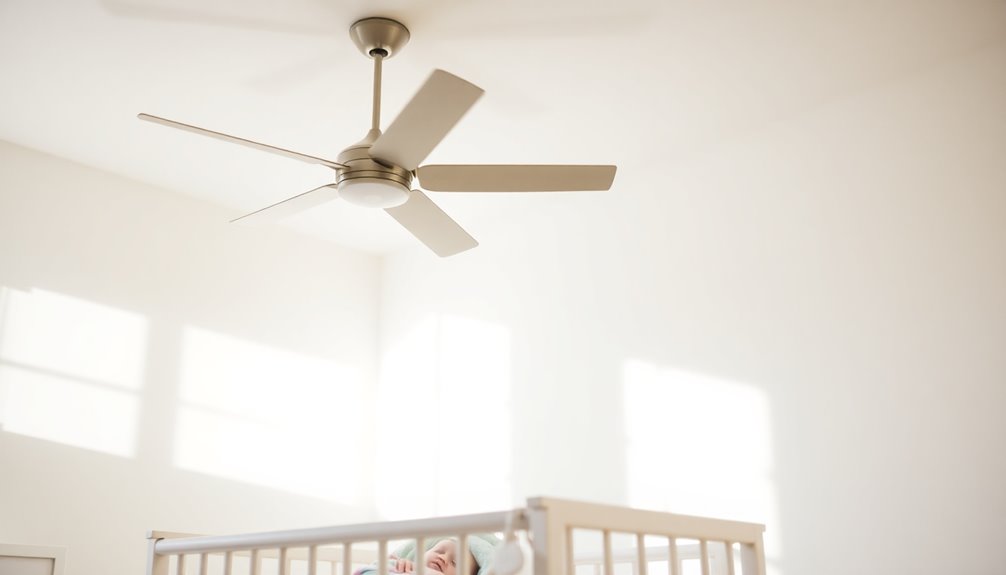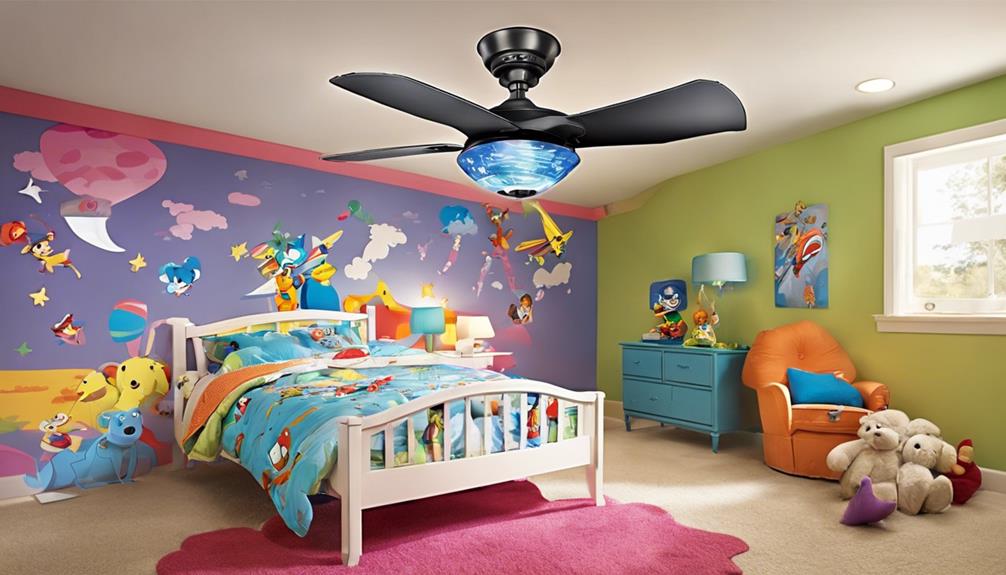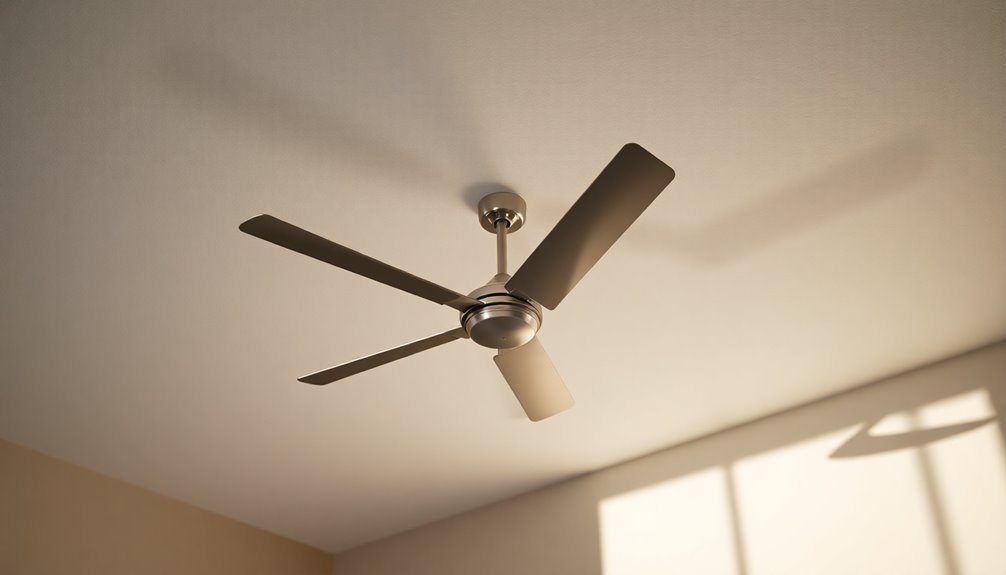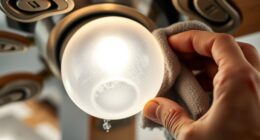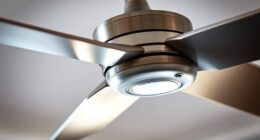Yes, ceiling fans are energy efficient and can greatly reduce your electricity usage. They consume much less power than air conditioning systems, helping lower your utility bills. With energy-efficient models like those certified by ENERGY STAR, you can enjoy up to 60% more efficiency than standard fans. In summer, they create a cooling breeze, while in winter, running them clockwise can help circulate warm air, saving you more on heating costs. Choosing the right fan and using it effectively can boost your energy savings even further. Explore more ways to maximize efficiency and comfort with your ceiling fan!
Key Takeaways
- Ceiling fans use significantly less electricity than air conditioning, enhancing overall energy efficiency in homes.
- ENERGY STAR certified fans are 60% more efficient than standard models, providing substantial savings.
- Efficient ceiling fans exceed 100 cubic feet per minute (CFM) per watt in airflow ratings, optimizing energy use.
- Reversible blade designs allow fans to circulate warm air in winter and cool air in summer, maximizing efficiency year-round.
- Regular maintenance, including filter replacement, ensures ceiling fans operate at peak energy efficiency.
Understanding Energy Efficiency

Energy efficiency is a critical concept for homeowners looking to reduce their utility bills and minimize environmental impact. When it comes to temperature regulation, ceiling fans stand out as a remarkably efficient alternative to air conditioning units. By using considerably less electricity, these fans not only keep you comfortable but also help you save energy in a big way.
The U.S. Department of Energy highlights that for every degree you raise your thermostat, you can save 1% on your utility bills—allowing you to increase settings by up to 4°F without sacrificing comfort. Opting for ENERGY STAR certified ceiling fans takes this a step further.
These fans are 60% more efficient than conventional models thanks to advanced motor technology and blade design, ensuring you get more airflow with less energy. Typically, high-efficiency ceiling fans exceed 100 CFM per watt in airflow ratings, showcasing their potential for greater energy conservation. Additionally, many models are designed to provide optimal air circulation while maintaining low energy consumption, further enhancing their efficiency.
Seasonal Benefits of Ceiling Fans

Ceiling fans offer impressive seasonal benefits that can help you save on energy costs year-round. They not only improve air circulation but also help maintain a comfortable indoor temperature, making them a smart investment for both summer and winter.
Here are three key advantages of using efficient ceiling fans:
- Winter Warmth: By reversing the fan's direction to clockwise, you can circulate warm air that rises to the ceiling, potentially saving up to 15% on your electric bills. This simple adjustment can enhance your heating system's efficiency, especially when paired with air purifiers that improve indoor air quality. Additionally, ensuring proper ventilation standards can further enhance the effectiveness of your heating system. Heat pumps can also work in conjunction with ceiling fans to maximize heating efficiency during colder months. A cooperative co-parenting plan can help to ensure that your home environment remains comfortable for everyone involved.
- Energy Savings: Using an ENERGY STAR® rated ceiling fan is a great way to boost energy efficiency. These fans are 20% more efficient than standard models, allowing you to enjoy greater comfort while cutting down on energy consumption.
- Thermostat Control: Properly utilized ceiling fans enable you to raise your thermostat settings by up to 4°F in winter without sacrificing comfort. This leads to additional energy savings and reduced reliance on conventional heating methods.
In addition to these benefits, ceiling fans can complement energy-efficient heating systems by providing an extra layer of comfort and reducing the overall load on HVAC systems.
With these benefits, it's clear that ceiling fans can considerably contribute to your home's energy efficiency throughout the seasons.
Selecting the Right Ceiling Fan

Choosing the right ceiling fan can make a significant difference in your home's comfort and energy efficiency. Start by checking the fan's airflow rating (CFM) per watt. Efficient fans typically exceed 100 CFM per watt at high speeds. When considering room size, select a fan with the appropriate blade span: small rooms (<75 sq. ft.) need 29-36 inch blades, while larger spaces (144-225 sq. ft.) require 44-54 inch blades. Additionally, opting for fans with smart technology can further enhance energy efficiency and user convenience. High-performance ratings ensure that your ceiling fan operates reliably and efficiently across varying conditions. Furthermore, consider incorporating a home security system to complement the safety and efficiency of your home environment.
Regular maintenance, such as filter replacement, can also help ensure that your ceiling fan continues to operate at peak efficiency.
Look for ENERGY STAR® certified models, which are 60% more efficient than conventional fans. This can lead to noticeable energy savings! Additionally, evaluate features like reversible blades for seasonal use, ensuring comfort year-round. To maintain a healthy indoor air quality, consider HEPA filter vacuums that can help eliminate allergens in your home.
Here's a quick comparison to help you visualize your options:
| Feature | Standard Fan | ENERGY STAR Fan |
|---|---|---|
| Efficiency | Less than 100 CFM/W | Over 100 CFM/W |
| Noise Levels | Moderate to High | Low to Moderate |
| Integrated Lighting | Optional | Often Included
Design and Aesthetic Considerations

When you think about adding a ceiling fan to your space, consider how its design can enhance your room's overall aesthetic. A ceiling fan isn't just functional; it can serve as a striking design statement that complements your interior decor.
With a variety of styles available—modern, industrial, and coastal—you're sure to find one that fits your theme.
Here are three key design considerations:
- Color Options: Popular finishes like matte black, brushed nickel, and oil-rubbed bronze allow you to match or elevate your existing decor.
- Blade Designs: Many modern ceiling fans feature reversible blade designs, offering versatility with dual color options to suit your mood or seasonal changes.
- Integrated Lighting: Consider fans with energy-efficient light kits, such as dimmable LED options, which not only enhance functionality but also contribute to the overall design appeal.
Additionally, bladeless ceiling fans provide a sleek, minimalist aesthetic while promoting efficient air circulation.
Leading Brands and Market Trends

As you explore ceiling fan options, it's important to contemplate the leading brands that prioritize energy efficiency and innovative designs. Companies like Hunter Fan Company, Casablanca Fan Company, and Westinghouse Electric Company focus on creating ceiling fans that meet your needs while conserving energy.
Look for ENERGY STAR® rated ceiling fans, as they're 20% more efficient than standard models, making them a smart choice for anyone conscious about energy consumption.
Fanimation and Minka Aire are other brands worth considering, offering a wide range of customizable designs that cater to different tastes while emphasizing energy conservation.
When evaluating options, pay attention to the efficiency ratings, which measure airflow (CFM) per watt. High-efficiency models often exceed 100 CFM per watt, ensuring you get maximum airflow with minimal energy use.
Market trends show a rising preference for ceiling fans featuring integrated LED lighting and smart technology. These advancements not only enhance energy efficiency but also provide added convenience in controlling your home's climate.
Frequently Asked Questions
Do Ceiling Fans Use a Lot of Electricity?
No, ceiling fans don't use a lot of electricity. They typically consume between 30 to 100 watts, which is considerably less than air conditioning units that can exceed 2,000 watts.
By using a ceiling fan, you can keep your space comfortable without driving up your energy bill.
Plus, if you combine it with air conditioning, you can even raise the thermostat by a few degrees without sacrificing comfort, saving you more on electricity costs.
Can Ceiling Fans Cause a High Electric Bill?
Yes, ceiling fans can cause a high electric bill if you leave them running in unoccupied rooms.
While they use less energy than air conditioners, constant operation in empty spaces wastes electricity.
To avoid unnecessary costs, make sure you turn off the fan when you leave a room.
Additionally, using an ENERGY STAR® certified fan can enhance efficiency, helping you save money while keeping your space comfortable.
Is It Cheaper to Run Ceiling Fans or AC?
Running ceiling fans is like choosing a gentle breeze over a roaring storm—much cheaper.
Fans use considerably less energy than air conditioning, allowing you to save on your electricity bill. In fact, by using a ceiling fan, you can raise your thermostat settings and still stay comfortable, leading to even more savings.
When you combine fans with AC, you can cut cooling costs by up to 15%, making fans a smart choice.
Is It Good to Leave Ceiling Fans on All the Time?
Leaving ceiling fans on all the time isn't a good idea.
They create a wind-chill effect that only cools the air for people in the room. If no one's there, you're just wasting energy and potentially adding heat to the space.
To save on your electricity bills, turn off the fan when you leave a room. You can also consider using occupancy sensors for automatic control to maximize efficiency.
Conclusion
Incorporating ceiling fans into your home is like adding a breeze of fresh air to your energy bills. They not only enhance comfort but also boost your energy efficiency year-round. By understanding their seasonal benefits and selecting the right fan for your space, you can enjoy both style and savings. So go ahead, embrace the coolness and let your ceiling fan work its magic while keeping your energy costs down. It's a win-win!
